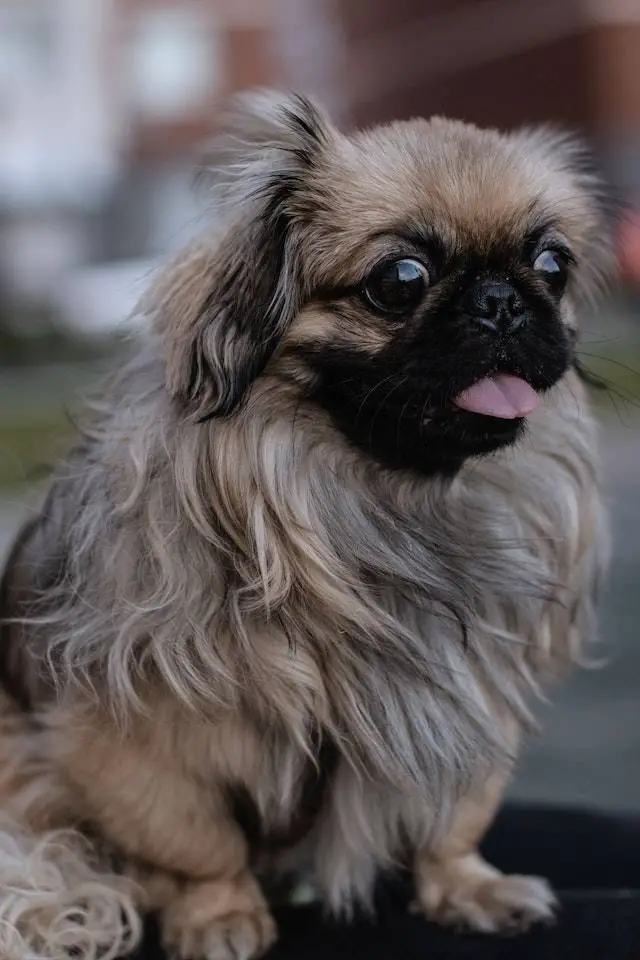9 Common Pekingese Eye Problems

Pekingese eye problems are common and can include dry eye, red eyes, and a discharge from the eyes.
These problems can be caused by a variety of factors, including allergies, fleas, and infections.
If you notice your Pekingese is having any of these eye problems, it’s important to take him to the veterinarian for a checkup.
How to identify a Pekingese with eye problems
Here are some signs that your Pekingese dog may have eye problems:
- Excessive tearing or discharge from the eyes.
- Squinting or rubbing of the eyes.
- Cloudiness or redness in the eyes.
- Sensitivity to light or changes in vision.
- Visible abnormalities in the shape or size of the eyes.
If you notice any of these signs in your Pekingese dog, it is important to take them to a veterinarian for a thorough examination and appropriate treatment.
Eye problems in Pekingese dogs can be quite common, and if left untreated, they can lead to serious complications and even blindness.
Regular check-ups with a vet can help catch eye problems early on and prevent them from getting worse.
Common Pekingese Eye Problems

The following are some common Pekingese eye problems you should know:
1. Dry Eye – Keratoconjunctivitis Sicca (KCS)
A Pekingese dry eye is a condition that causes the eyes to become dry and irritated.
It can be caused by several different factors, including allergies and infections.
Treatment for dry eyes includes artificial tears and ointments to keep the area moist.
If your dog has KCS (keratoconjunctivitis sicca), contact your veterinarian immediately for further treatment options if you notice any signs of discomfort such as redness or pain in his eyes.
2. Third eyelid prolapse
The third eyelid is a thin fold of skin that covers the eye and opens when you blink.
Third eyelid prolapse is a condition where the third eyelid, also known as the nictitating membrane, of a dog, protrudes outwards from its normal position.
Pekingese dogs are particularly susceptible to this condition due to their extremely brachycephalic head shape.
Third eyelid prolapse can be caused by a variety of factors, including trauma, inflammation, and genetic predisposition.
If left untreated, it can lead to dry eyes and other complications. Treatment typically involves a surgical intervention to reposition the third eyelid gland back in its normal position.
Proper care and management, as well as regular visits to the vet, can help prevent the onset of this condition in Pekingese dogs.
3. Corneal ulcers
Corneal ulcers are a serious condition that can lead to blindness.
They’re caused by bacteria, trauma, or foreign bodies, and they can be treated with antibiotics and anti-inflammatory drugs.
Corneal ulcers in Pekingese eyes are often caused by corneal abrasion (a scratch or scrape on the eye).
But there’s also a chance it could be an infection in those cases where there’s no visible damage on your dog’s cornea.
Read more: 8 Top Pekingese Old Age Symptoms And Problems.
4. Kinked eyelashes
Kinked eyelashes are a common problem in Pekingese. Keep in mind that kinked eyelashes can be caused by infection, trauma, or allergies.
Infection is the most common cause of kinky eyelashes and corneal ulceration (a painful condition on the eye).
If your dog has this problem, it needs to see an ophthalmologist immediately so that he or she can remove the bacteria causing this condition and treat it properly with antibiotics.
If left untreated for too long, kinky eyelashes may develop into corneal ulcers which will lead to blindness if not treated quickly enough
5. Cherry eye
Cherry eye is a common problem in the Pekingese and other breeds that have a third eyelid.
The gland on the underside of the eyelid drains fluid from the third eyelid, which can become blocked and cause irritation to the eye.
This can be treated by surgery or medication, but it’s best to prevent cherry eye by keeping your dog’s eyes clean at all times.
6. Cataracts
Pekingese dogs are among the breeds that are at a higher risk of developing cataracts, which is a cloudiness in the eye lens that can lead to partial or complete vision loss.
The extreme brachycephalic head shape of Pekingese dogs is thought to contribute to the development of cataracts.
Cataracts in Pekingese dogs can occur as a congenital condition or may develop later in life. In some cases, cataracts can be surgically corrected, but this is not an option for all dogs.
If you suspect that your Pekingese may have cataracts, it is best to consult with a veterinarian for proper diagnosis and treatment options.
7. Ectropion (the eyelid turns out from the eye)
Ectropion (the eyelid turns out from the eye) is a condition in which the eyelid turns outward and can cause corneal ulcers.
The condition may be caused by trauma, which damages the muscles of your pet’s face.
In some cases, ectropion can be inherited or congenital in nature; however, this doesn’t mean that you should ignore it if your dog has it!
If you notice signs of ectropion on your Pekingese’s eyelids like swelling or discoloration of their eyes.
Contact your vet immediately so they can diagnose what exactly happened to cause this problem and decide whether surgery would be beneficial for him/her.
Learn more about: Why Do Pekingese Cry
8. Entropion (the eyelid turns in towards the eye)
Entropion is a condition where the eyelid turns inward and rubs against the cornea, causing irritation or pain. The lashes can also rub against the eye and cause corneal ulcers.
Entropion can be caused by genetics, trauma, or infection; however, it’s more common in Pekingese that have had their eyes examined for entropion without an exam being performed on their mouths.
9. Keratitis (inflammation of the cornea)
Keep in mind that keratitis is an inflammation of the cornea, which is the clear outer layer of your eye.
Keratitis can be caused by bacteria or fungus, but it’s more often caused by other organisms that enter your eye through a foreign body and cause an immune response in your body.
If your dog has keratitis, you may notice that light sensitivity increases as the infection progresses.
You may also notice that some colors are less bright than others (this is called color blindness).
This occurs because light waves are not being absorbed as effectively by infected cells.
The result is that colors appear darker than they really are; however, this effect doesn’t last long after treatment begins!
Taking Care of a Pekingese with Eye Problems
To take care of a Pekingese with eye problems, it is important to keep their eyes clean and moisturized.
You can use a sterile saline solution to clean their eyes daily and apply ophthalmic ointment or other prescribed medications as recommended by your veterinarian.
Regular visits to the vet for eye exams can also help detect eye problems in their early stages.
Read more: How To Care For a Pekingese.
Ways to care for a Pekingese eye

Caring for a Pekingese dog’s eyes is very important as they are prone to various eye problems.
Here are some of the ways to care for a Pekingese’s eyes:
- Keep their eyes clean: Regularly clean their eyes with a damp cloth to remove any dirt or discharge.
- Use eye drops: Pekingese dogs are prone to dry eyes, so eye drops may be necessary to keep their eyes moisturized.
- Watch for signs of eye problems: Be alert for any signs of eye problems such as redness, swelling, or discharge, and seek veterinary help immediately.
- Avoid harsh environmental factors: Avoid exposing them to harsh environmental factors such as strong winds, dust, or smoke as these can irritate their eyes.
- Regular vet check-ups: Regular eye check-ups with a veterinarian can help identify and address any potential issues before they become serious.
- Proper nutrition: Pekingese dogs require a balanced diet that includes good sources of Vitamin A and fatty acids, which promotes eye health.
- Keep them hydrated: Ensure that they have access to clean water at all times as dehydration can affect their eye health.
- Prevent trauma: Be mindful of their surroundings and avoid situations that may lead to eye trauma.
- Consider genetic testing: Pekingese dogs are prone to eye problems due to their genetics. Consider genetic tests to determine any potential problems that may arise, prevent them from happening, and ensure proper care.
Overall, caring for Pekingese’s eyes requires a combination of preventive measures, regular vet check-ups, and proper nutrition.
This will help maintain their eye health and prevent potential problems.
Learn more about caring for Pekingese eyes.
Preventive Measures for Pekingese Eye Problems
Here are some preventive measures that you can take to reduce the risk of eye problems in Pekingese:
- Keep the fur around their eyes clean and trimmed through regular grooming.
- Clean the face and around the eyes daily with a damp cotton ball to prevent problems with the skin folds in the face.
- Take precautionary measures to ensure that your Pekingese puppy doesn’t jump off furniture or stairs, which can lead to eye injuries.
- Consider using protective eyewear such as dog goggles to prevent eye injuries when engaging in outdoor activities.
- Regularly visit your veterinarian for checkups and preventative care, which can help detect eye problems early and prevent them from becoming more severe.
Learn more about Pekingese health concerns.
Related Questions
Can Pekingese eye problems be prevented?
While not all Pekingese eye problems can be prevented, there are steps you can take to promote eye health in your Pekingese. Regular veterinary checkups, a healthy diet, and keeping your Pekingese away from irritants and environmental hazards can all help.
What is the treatment for Pekingese eye problems?
The treatment for Pekingese eye problems will depend on the specific condition that your dog is experiencing. Treatment options may include medications, surgery, or other forms of treatment as recommended by your veterinarian.
Are some Pekingese more prone to eye problems than others?
Yes, certain Pekingese bloodlines may be more prone to certain eye problems than others. It’s important to talk to your breeder and veterinarian about the health history of your Pekingese to understand their risk for eye problems.
How can I keep my Pekingese comfortable if they have an eye problem?
If your Pekingese is experiencing an eye problem, they may be uncomfortable and in need of extra care. Keeping their eyes clean and providing them with a comfortable area to rest can help. It’s also important to follow your veterinarian’s instructions for medication or treatment.
Conclusion
Pekingese are prone to eyes being bulgy and can develop problems.
This includes dry eye, third eyelid prolapse, corneal ulcers, and KCS (keratoconjunctivitis sicca).
If your Pekingese has these symptoms, visit an eye specialist immediately!
